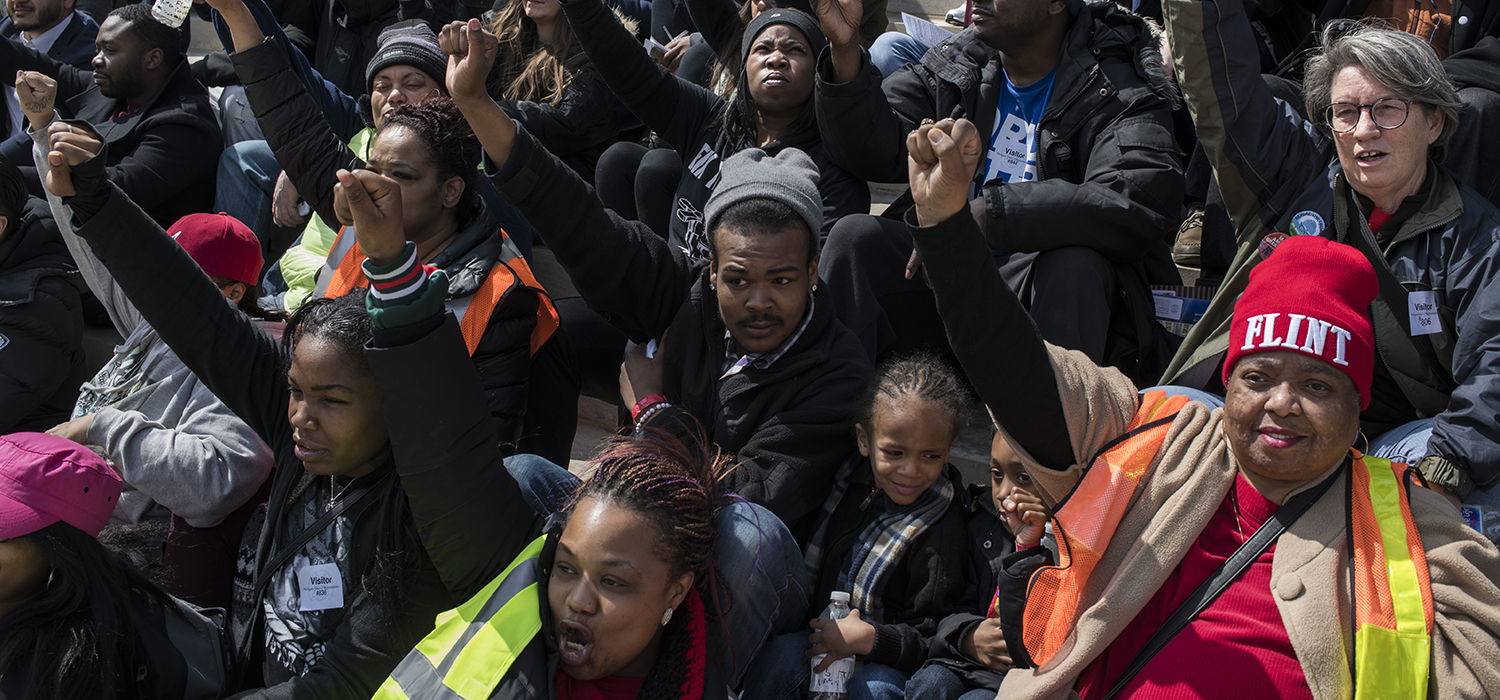
<p>Flint residents and allies from regions nearby pose for a group photo during a protest on the steps of the Michigan State Capitol on April 11, 2018 in Lansing, Michigan. The state-run water distribution sites are closing after officials said the water quality is meeting federal standards. This has left residents scrambling to find an alternative as many still do not feel it is safe to drink the tap water even with a filter. (Photo by Brittany Greeson / Getty Images)</p>
From its earliest days, environmental justice research has been rooted in the social movement that gave its name to the field. Grassroots activists against income and racial discrimination in the placement of environmental pollutants—and the overlooking of low-income and communities of color for environmental amenities—have enlisted toxicologists, demographers, engineers, and public health scholars to uncover damages.
Starting with analysis of the 1982 toxic waste site in the predominately Black community Warren County, North Carolina, and continuing today with studies of the tainted waters in Flint, Michigan, and Jackson, Mississippi, these researchers continue to bring to light systemic inequities in environmental justice. Rigorous studies (PDF) have found that race is the most significant factor in siting hazardous waste facilities and where particulates end up getting emitted into nearby air, soil, and water, thereby creating “sacrifice zones” and communities at the frontlines of hazard exposures.
Scholars continue to build on this fundamental work, expanding analysis with new empirical techniques and documentation. Researchers have also begun to conduct their work with an eye on informing the range of policies that tacitly permit and, in some cases, intend these outcomes: environmental regulations, land-use laws, public infrastructure investments, and industrial practices. In short, the scholarship continues to align with the movement.
But much work is still needed, including pushing disciplinary boundaries further, increasing methodological rigor, and ensuring research centers community-based participation.
Environmental experts from economic, sociological, and community-centric disciplines discussed the future of environmental justice research at a recent virtual event cohosted by Resources for the Future with the Urban Institute. The panelists suggested that market factors, political power, and systemic inequality could contribute to injustice and that the future of the movement must prioritize equity and work with communities to achieve environmental justice.
The root causes of environmental effects are difficult to untangle—but the inequity is real
Early researchers focused on reacting to negative environmental conditions, often trying to determine whether predominately low-income communities were forced to settle around polluting facilities or if facilities took advantage of market conditions and disenfranchised communities for their location.
Either way, the answer masks whether the outcomes can be called the product of racism and “dangerously suggests that inequitable outcomes are a natural consequence of socioeconomic life,” according to Sheila Foster, professor of urban law and policy at Georgetown University. To achieve environmental justice, researchers need to recognize factors beyond market or lifestyle choices, Foster added, and center the experiences of people of color.
Some recent studies by economists on these issues have found that people of color are being steered into less desirable neighborhoods, according to Lala Ma, assistant professor in the University of Kentucky’s Gatton College of Business and Economics. Ma also stressed that to isolate the root causes of inequitable environmental effects, researchers will need to question their own baseline assumptions. Targeting the racist policies and antipoor decisions that perpetuate these conditions, such as historical redlining, must be part of the researcher’s framework—much like the environmental justice scholars before.
Future environmental justice research should prioritize community-based approaches
Consequently, the research can only go so far, according to Manuel Pastor, professor of sociology and American studies and ethnicity at the University of Southern California. Multiple studies have shown the negative effects of hazardous waste siting on the health and well-being of surrounding communities, but little was done to rectify the situation, Pastor said. He believes the next frontiers of environmental justice are taking “precautionary, preventative, and cumulative” approaches that address the underlying compounding effects of multiple environmental shocks and persistent social stressors on the same communities.
By taking a cumulative, neighborhood-centric approach, researchers can better demonstrate the severity of exposure communities experience. This approach will be critical for emerging environmental hazards—like climate change’s effects or pandemic recovery—for which environmental justice activists are pivoting to be proactive.
To do so, researchers should look through “the lens of equity at the neighborhood level,” Foster said. Partnering with existing community organizations to incorporate contextual factors can ensure what Pastor called “ground truthing,” or taking state-provided data, fostering citizen scientists, and going door-to-door to affirm its accuracy.
But researchers also need to be clearer about policies’ unintended effects. Ma noted that when policy helps decrease pollution in neighborhoods, it can also make that neighborhood more desirable and drive up housing costs. As a result, the original community may be hurt from interventions intending to help.
Taking on the historical equity lens—not just the snapshot of fairness
Ultimately, researchers need to “shake off the equality mindset and begin to think equitably to account for where people already are and correct for past patterns of disparity,” Pastor said. Researchers can start designing better research by working across disciplines, taking a cumulative approach, and partnering with those already in the community.
The environmental justice movement started with community advocates and researchers working in parallel, and its next steps, given the recent presidential executive order to expand and pursue federal environmental justice actions and related Congressional legislation, necessitates they continue to work together.
The Urban Institute has the evidence to show what it will take to create a society where everyone has a fair shot at achieving their vision of success.
Let’s build a future where everyone, everywhere has the opportunity and power to thrive
Urban is more determined than ever to partner with changemakers to unlock opportunities that give people across the country a fair shot at reaching their fullest potential. Invest in Urban to power this type of work.